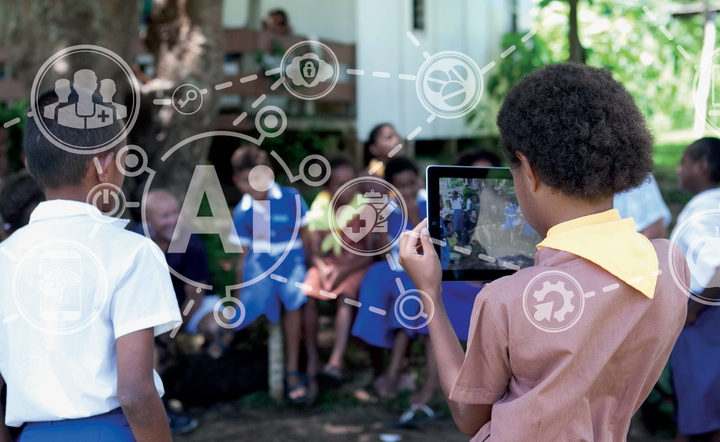
Artificial Intelligence or AI can create dynamic content. Let’s apply best use cases to our work as storytellers.
At this year’s Wimbledon Tennis Tournament, for example, IBM’s artificial intelligence platform, Watson, had a major editorial role -- analyzing and curating the best moments and data points from the matches, producing “Cognitive Highlight” videos, tagging relevant players and themes, and sharing the content with Wimbledon’s global fans.
Intel just announced a collaboration with the International Olympic Committee (IOC) that will bring VR, 360 replay technology, drones and AI to future Olympic experiences. In a recent press release Intel notes, “The power to choose what they want to see and how they want to experience the Olympic Games will be in the hands of the fans.”
In the context of development, future technology will change the way we interact with global communities. Researchers at Microsoft are experimenting with a new class of machine-learning software and tools to embed AI onto tiny intelligent devices. These “edge devices” don’t depend on internet connectivity, reduce bandwidth constraints and computational complexity, and limit memory requirements yet maintain accuracy, speed, and security — all of which can have a profound effect on the development landscape. Specific projects focus on small farmers in poor and developing countries, and on precision wind measurement and prediction.
Microsoft’s technology could help push the smarts to small cheap devices that can function in rural communities and places that are not connected to the cloud. These innovations could also make “the Internet of Things devices cheaper, making it easier to deploy them in developing countries,” according to a leading Microsoft researcher.
But the fact is, the non-western setting is currently the greatest challenge for AR/VR platforms. Wil Monte, founder and Director of Millipede, one of our SecondMuse collaborators says currently VR/AR platforms are completely hardware reliant, and being a new technology, often require a specification level that is cost-prohibitive to many.
Monte says labs like Microsoft pushing the processing capability of machine learning, while crunching the hardware requirements will mean that the implementation of the technologies will soon be much more feasible in a non-western or developing setting. He says development agencies should be empowered to push, optimise and democratise the technology so it has as many use cases as possible, therefore enabling storytellers to deploy much needed content to more people, in different settings.
"From our experience in Tonga, I learned that while the delivery of content via AR/VR is especially compelling, the infrastructure restraints means that we need to 'hack' the normal deployment and distribution strategies to enable the tech to have the furthest reach. With Millipede's lens applied, this would be immersive and game-based storytelling content, initially delivered on touch devices but also reinforced through a physical board or card game to enable as much participation in the story as possible,” Monte says.
According to Ali Khoshgozaran, Co-founder and CEO of Tilofy, an AI-powered trend forecasting company based in Los Angeles, content creation is one of the most exciting segments where technology can work hand in hand with human creativity to apply more data-driven, factual and interactive context to a story. For example, at Tilofy, they automatically generate insights and context behind all their machine generated trend forecasts. “When it comes to accessing knowledge and information, issues of digital divide, low literacy, low internet penetration rate and poor connectivity still affect hundreds of millions of people living in rural and underdeveloped communities all around the world,” Khoshgozaran says.
“This presents another great opportunity for technology to bridge the gap and bring the world closer. Microsoft use of AI in Skype’s real-time translator service has allowed people from the furthest corners of the world to connect -- even without understanding each other’s native language -- using a cellphone or a landline. Similarly, Google’s widely popular translate service has opened a wealth of content originally created in one language to many others. Due to its constant improvements in quality and number of languages covered, Google Translate might soon enhance or replace human-centric efforts like project Lingua by auto translating trending news at scale,” Khoshgozaran says.
Furthermore, technologies like the Google Tango and Apple ARKit can provide new opportunities says Ali Fardinpour, Research Scientist in Learning and Assessment via Augmented/Virtual Reality at CingleVue International in Australia. “The opportunity to bring iconic characters out of the literature and history and bring them to every kid's mobile phone or tablet and educate them on important issues and matters in life can be one of the benefits of Augmented Reality Storytelling.”
Fardinpour says this kind of technology can substitute for the lack of mainstream media coverage or misleading coverage to educate kids and even adults on the current development projects, “I am sure there are a lot of amazing young storytellers who would love the opportunity to create their own stories to tell to inspire their communities. And this is where AR/AI can play an important role.”
A profound view of the future of storytellers comes from Tash Tan, Co-Founder of Sydney based Digital Company S1T2. Tan is leading one of our immersive storytelling projects in the South Pacific called LAUNCH Legends aimed at addressing issues of healthy eating and nutrition through the use of emerging, interactive technologies. “As storytellers it is important to consider that perhaps we are one step closer to creating a truly dynamic story arch with Artificial intelligence. This means that stories won't be predetermined or pre-authored, or curated but instead they will be emerging and dynamically generated with every action or consequence,” Tan says, “If we can create a world that is intimate enough and subsequently immersive enough we can perhaps teach children through the best protagonist of all -- themselves.”
A version of this story first appeared on the United Nations System Staff College blog earlier today.
